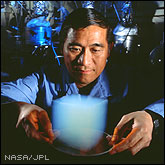Solid Smoke
 Ever wondered what is the least dense solid in the world? Well, it is the so called Solid Smoke aerogel developed decades ago by aerospace engineers and recently perfected to its newest, lightest formulation by NASA and JPL.
Ever wondered what is the least dense solid in the world? Well, it is the so called Solid Smoke aerogel developed decades ago by aerospace engineers and recently perfected to its newest, lightest formulation by NASA and JPL.
Solid Smoke is made of the same stuff glass is made of: silicon dioxide and sand; however it is more than a thousand times lighter than glass. The latest batch made by NASA/JPL that recently made the Guinness book of records weighed only 0.00011 pounds per cubic inch (3 milligrams per cubic centimeter). Essentially, Solid Smoke is 99.8% air!
Solid Smoke aerogel has some amazing properties unlike any other natural or man-made material. It is extremely durable, has a uniquely low thermal conductivity, refractive index, and sound speed, and can withstand extreme temperatures of up to 2,600 degrees F (1,400 degrees C). These properties make it a great insulator. Experimental samples have been flown on the Space Shuttle, the Mir space station and the Mars Pathfinder; however, in the near future, we may see this material used to insulate our homes, refrigerators, furnaces and car engines. Another amazing property of Solid Smoke is that it can efficiently capture fast-flying particles, such as those entering the Earth's atmosphere or those in the tails of comets. The NASA included a piece of this material on board the Stardust spacecraft which finished collecting interstellar dust, including recently discovered dust streaming into our Solar System from the direction of Sagittarius, on December 13, 2002. These samples will be returned to Earth in 2006 when the scientists will extract them from the Solid Smoke and study them.
About the Author
Anton Skorucak, MS
 Anton Skorucak is a founder and publisher of ScienceIQ.com. Anton Skorucak has a Master of Science (MS) degree in physics from the University of Southern California, Los Angeles, California and a B.Sc. in physics with a minor in material science from the McMaster University, Canada. He is the president and creator of PhysLink.com, a comprehensive physics and astronomy online education, research and reference web site.
Anton Skorucak is a founder and publisher of ScienceIQ.com. Anton Skorucak has a Master of Science (MS) degree in physics from the University of Southern California, Los Angeles, California and a B.Sc. in physics with a minor in material science from the McMaster University, Canada. He is the president and creator of PhysLink.com, a comprehensive physics and astronomy online education, research and reference web site.


